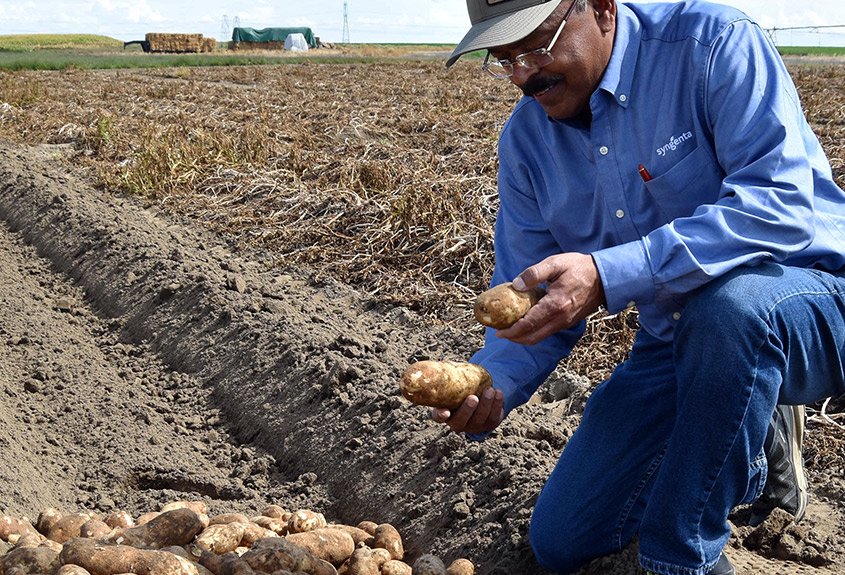The Macro Impact of Microorganisms
Plant viruses require a global effort to minimize their impacts on crop productivity and grower profitability.

Most researchers whose life’s work is addressing the prevalence and impact of plant viruses say they aren’t a new agricultural problem. But viruses evolve and adapt rapidly, posing a challenge that’s intensifying over time — intensifying as in causing $60 billion in crop losses worldwide, according to a 2019 estimate1. Pre-pandemic, we might have referred to this growing threat as “going viral” — after all, we are talking about viruses. Since this feels like a good time to retire that phrase, let’s instead say we have a problem with microorganisms going macro.The neonicotinoid class of chemistry was introduced just before the turn of the century. And since the introduction, there has been a marked reduction of PLRV in potatoes in North America.
It’s an impact that can devastate a field. For instance, the Soybean Research & Information Initiative reports:2
- Yield losses of nearly 52% in southern germplasm due to bean pod mottle virus (BPMV)
- Losses from soybean mosaic virus (SMV) as high as 94%.
- Complete yield loss in many cases when both BPMV and SMV infect soybeans, because symptoms are more severe than those either virus produces alone
Viral synergism and climate change are among the factors contributing to the prevalence and severity of viral disease, according to associate professor and South Dakota State University Extension plant pathologist Emmanuel Byamukama, Ph.D.
“Viral synergism, when multiple species are playing tag team in an infected plant, has been observed more frequently and can result in increased accumulation of one or more viruses, causing more severe symptoms than if only one was present,” Byamukama says.
In regard to climate change, he says, warmer temperatures for longer periods of time extend the reproduction period and life span of insect vectors, allowing more opportunity for virus transmission.
Taking a Multidisciplinary Approach
Kiran Shetty, Ph.D., Syngenta technical development lead for potatoes, points out that viruses continually evolve. Through mutation, recombination and genetic material changes, viruses reorganize and adapt.
For instance, the number of Potato Virus Y (PVY) strains detected in U.S. potato fields has increased substantially. “Before the 2000s, we only had one strain of PVY impacting commercial potato production, and it primarily resulted in yield loss,” says Jonathan Whitworth, Ph.D., a research plant pathologist with the U.S. Department of Agriculture’s Agricultural Research Service (USDA-ARS). “Since then, we have identified several new strains of PVY in grower fields that are also causing necrosis, which impacts tuber quality as well.”
The good news is that through advancements in technology and global connectivity, researchers and breeders can share information more rapidly, identify potential challenges more quickly, and leverage tools and resources to fight the battle head on. That connectivity is essential to the multi-agency and multi-disciplinary approach needed to control viruses.
Regulators concentrate on containing viruses. Certified seed organizations help ensure a clean start. Entomologists evaluate insect control measures. And breeders focus on developing resistant varieties.
Containing A Virus
Because there is no cure for viruses nor a way to control them once they infect a plant, preventive measures are the best way to reduce viral risk. “The best line of defense against a virus is to keep it out,” Byamukama says. “On a global scale, we do this by ensuring that plant materials being imported from other countries or being transported from one region of the U.S. to another are clean and don’t hide pathogens and arthropods.”
On-farm, commercial growers can minimize the risk of infection by using certified seed. In the case of potatoes, stem cutting and micropropagation techniques, in which plantlets are grown in tissue culture, help obtain pest-free potato plants for propagation and production of certified seed tubers. Several generations of plants are grown in the field to produce certified seed tubers for commercial growers.
“PVY can be highly detrimental to seed growers, as it greatly impacts their ability to sell higher-quality seed,” Whitworth says. “For the commercial grower, the biggest impact is probably yield loss. Our studies have shown that for about every 1% of PVY you have in a commercial crop, you can lose about 1.5 sacks, or 150 pounds, of potatoes. And the quality defects caused by necrosis can result in a lot being rejected by the buyer.”
“Detection and proper diagnosis during the certification process help ensure that seed pieces do not carry viruses into a newly planted commercial field,” Shetty says. “The states in the Pacific Northwest, for instance, work very closely to ensure that seed lots are not infected with potentially damaging viruses like PVY.”
Hygiene is important at the farm level as well. Cleaning equipment before transporting it between fields is an important prevention measure growers can implement to reduce spread.
Controlling the Vector Factor
The next step to protecting commercial crops from viruses is controlling the vectors. In most cases, the vectors that transmit plant viruses from one living plant to another are insects. Though some vectors are more efficient than others, all must be controlled to stop the spread.
Byamukama warns, “By the time you see symptoms in the field, it is too late. Once one plant in the field is infected, you can’t cure it - you can only prevent the virus’s spread to other plants.”
Applications to stop the spread can sometimes start with seed treatments.
For instance, Byamukama says, “Bean leaf beetles, the vector of BPMV, survive the winter as adults and emerge in the spring to feed on seedling plants. A seed treatment insecticide kills the vector upon feeding, which means it will only affect that one plant, if the beetle was already carrying the virus in its body - as opposed to the beetle’s feeding and transmitting the virus to several plants in the same field.”
In potatoes, the use of neonicotinoid insecticides has been instrumental in the control of the aphid species that transmit potato leafroll virus (PLRV). PLRV can cause yield loss and tuber net necrosis, making harvested potatoes unsuitable for fresh market, processing or seed.
“The neonicotinoid class of chemistry was introduced just before the turn of the century,” Shetty says. “And since the introduction, there has been a marked reduction of PLRV in potatoes in North America. Syngenta has been a leader in the development of potato seed treatments containing neonicotinoids that protect young plants from the get-go.”
For viruses that primarily affect plants in early stages of development, producers can adjust planting to avoid times when vectors are active. Vectors will move to other hosts, eliminating concurrency of the crop and vectors in the field.
Breeding for Built-in Protection
In-field measures are the opening act in controlling plant viruses. The endgame is breeding varieties with genetic resistance.
All plants have natural defense mechanisms, including resistance to viruses. Breeders select for these beneficial genetics for built-in protection. “In extension, we like to refer to resistant varieties as the low-hanging fruit,” Byamukama says. “They do not cost much more than susceptible varieties, and, if plants do become infected, they help reduce the severity of symptoms to protect crop yield and quality.”
In the world of produce, quality is of utmost importance and can make or break a crop. Preventing viruses in fruiting vegetable crops, such as tomatoes, is a must due to the market’s strict quality standards.
“When growing fruiting crops, pesticide use is highly restricted once the fruit is developed. “The ability to leverage genetic resistance as a primary solution is critical,” says Gregori Bonnet, Syngenta seeds principal scientist, who leads a team of trait project leads dedicated to developing genetic resistance in fruiting crops.
According to Ruud Kaagman, global crop unit head for tomatoes, Syngenta screens thousands of tomato lines, and wild material, annually to identify those that exhibit natural resistance to viruses.
“Syngenta has a global center of excellence with the resources and knowledge to solve major disease issues,” Kaagman says. “We are able to identify sustainable solutions in addressing potential outbreaks long-term by combining different resistances and resistance mechanisms.”
Tobamoviruses, a diverse group of viruses that caused severe outbreaks in tomatoes in recent years, are a primary focus for Syngenta. Tomato brown rugose fruit virus (ToBRFV), which first emerged in Israel in 2014, has spread to tomato fields and greenhouses across the Middle East, Europe, Mexico, North America and other parts of the world. ToBRFV damages the quality and yield of tomato crops and has forced the temporary shutdown of some major greenhouse operations.
Earlier this year, Syngenta introduced its second beefsteak tomato variety with resistance to ToBRFV and plans to introduce broad resistance into its full portfolio of tomato varieties over the next several years.
In potatoes, the USDA is working closely with industry partners to encourage the adoption of resistant varieties through grower education.
“We have multidisciplinary grants focused on viruses that cause necrotic defects in tubers and have done PVY demonstration plots in Washington, Wisconsin and Maine with as many as 20 varieties, specific to each region,” Whitworth says. “These real-time educational experiences show growers how the virus is expressed in plants and allow us to focus on how resistant varieties, combined with cultural practices, can prevent viral infection and protect crop yield and quality.”
1 Pierre Lefeuvre, Darren P. Martin, Santiago F. Elena, Dionne N. Shepherd, Philippe Roumagnac, Arvind Varsani. Evolution and ecology of plant viruses. Nature Reviews Microbiology, 2019
2 https://www.soybeanresearchinfo.com/diseases/soybeanviruses.html
Gene science and predictive breeding accelerate improvements in #wheat varieties.
click to tweet ![]()

